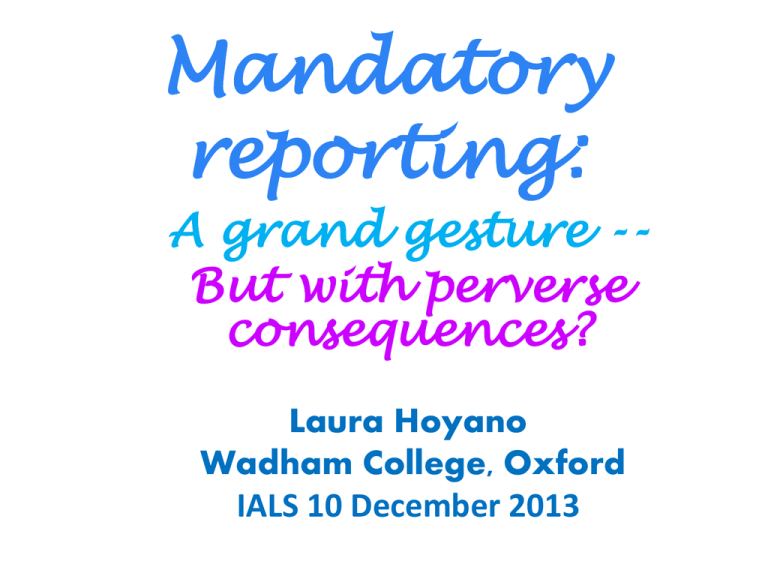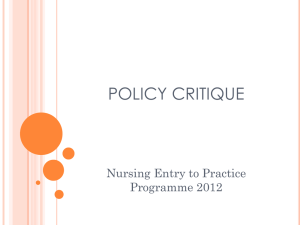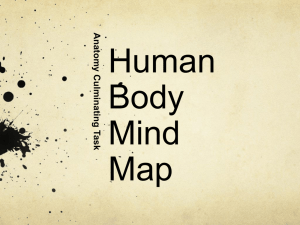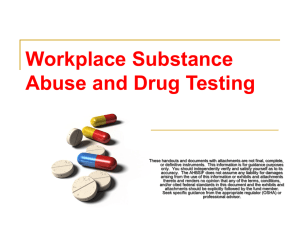Presentation by Laura Hoyano - Institute of Advanced Legal Studies
advertisement

Mandatory reporting: A grand gesture -But with perverse consequences? Laura Hoyano Wadham College, Oxford IALS 10 December 2013 (1) The ‘Pontius Pilate’ effect • Deterioration in community cohesion and cooperation as every neighbour can become a reporter Isolation for families in need of support Increased risk to children • After a report has been made, those surrounding the child, including neighbours, teachers, and health professionals, relax their vigilance • (Erroneous) assumption that the ‘experts’ (police, social services) will protect the child once they are notified [(eg X v Beds CC (HL 1995)] • MR laws = merely a reporting system, not intervention! • Overwhelmed social services raise the barriers to investigation eg Victoria (Aus) 1992-93: 92% of notifications investigated 1993 MR introduced 1999-2000: only 40% investigated • Health professionals spend more training time on how to protect themselves from criminal liability for failure to report than on how to detect, protect and treat children at risk (US Institute of Medicine, 2002) (2) Child Protection Providers become Investigators not Safeguarders • Welfare concerns are treated as allegations of wrongdoing from the outset, without assessment of need for support services • A tidal surge of allegations: US: MR in all states & territories [Federal Child Abuse Prevention and Treatment Act (1974)] • 2010: ca. 3.3 million reports to child protection agencies US Govt, Administration on Children and Families, 2003: 1/8 of reports are screened out without investigation 2/3 of investigated reports are never substantiated substantial proportion of validated reports do not result in any services for the child “an enormously successful calamitous system” [Melton (2005)] which has caused “chronic and critical multiple organ failure” within the child protection system [US Advisory Board on Child Abuse and Neglect, 1990] (2) Investigators not Safeguarders Australia New South Wales: >10% of children in entire population referred by age 5 – >190,000 referrals p.a. [NSW Department of Community Services (2005)] 78.7% of notifications unsubstantiated (1999-2000: Ainscough, 2002) Queensland: “an unsustainable increase in reports” from mandated reporters [Queensland Child Protection Commission of Enquiry, 2013, p. 22] Only 4,359 of 114,503 reports substantiated on investigation (2011-12) Fewer than ¼ of reports met the threshold for notification (“reasonable suspicion that child in need of protection”) 78% of investigated reports concluded that the child’s safety was not at risk so no follow-up action (Queensland Child Protection Commission of Enquiry, 2013: "… The over-reporting of children to Child Safety Services is inefficient, not to mention damaging to those families who are being unnecessarily reported.“) Western Australia: NO MR laws Same period as NSW: only 55.8% of notifications were unsubstantiated Mandatory reporting rejected by the Government as counter-productive in 2002 (research study by Harries & Clare, 2002) (3) Victims are deterred from seeking help from mandatory reporters • E.g. sexual health clinics, sexual assault crisis centres, child helplines, health professionals, schools, counsellors, community workers • Children may want intervention, protection and/or treatment, not criminal prosecution – the abuser deprives them of autonomy and choice, and the law should not do the same by making their secrets public against their wishes (obviously subject to any concerns about other children at risk). • Children are catapulted into the criminal justice system without proper preparation whereas adult victims are given the time they wish. • investigations are foiled where children cannot be persuaded to cooperate • SO: mandatory reporting regimes can harm (1) the child’s well-being and recovery and (2) evidence-gathering for eventual prosecution [Hoyano & Keenan Child Abuse Law and Policy across Boundaries] (4) Conflict of interest for professionals • Do they protect themselves from criminal liability by reporting, or exercise their professional judgment as to what is in the best interests of the child, respecting that child’s autonomy? (UN Convention on the Rights of the Child Art 19) • Breach of trust: undertakings of confidentiality are meaningless or not trusted by the victim deleterious impact on therapeutic relationships children often perceive coerced involvement as secondary abuse [Harries & Clare, 2002] • Self-censored record-keeping of disclosures • Concerns re historic abuse reports triggering liability • US: at least 2/3 of suspected maltreatment victims not reported by mandatory reporters [Sedlak (2011)] • US: “Rampant civil disobedience” by professionals who are convinced the children are worse off as a result of reports, and do not receive protection services [Melton 2005] (5) Families and offenders are deterred from seeking help • US: implementation of MR resulted in a dramatic decline in offenders’ revelations of child sexual abuse (Berlin, Mallon & Dean, 1991) • Loss of confidentiality: health and social care professionals perceived as prosecutors not therapeutic supporters • Stigmatisation, not assistance • Disruption in any treatment already underway • Disruption to the family • Low Countries: new assurances of confidentiality increased families’ self-referral for help (Marneff 1997) Paucity of prosecutions against non-reporters • Extremely few criminal prosecutions in all jurisdictions with mandatory reporting • US & Canada: MR laws primarily used in support of civil negligence actions to set up the duty to act • Problem of choosing whom to prosecute, especially in jurisdictions with universal reporting laws • Has not prevented cover-ups of institutional abuse, e.g. in clerical and residential school/care settings in all jurisdictions with MR laws Conclusions • “overwhelming evidence that mandatory reporting systems are in chaos worldwide” (Harries & Clare research report commissioned by Western Australia Child Protection Council, 2002) • Criminalising the public for failing to act is not the answer • Coercing and undermining professionals by criminal law is not the answer – they are already accountable: to children (but not parents) in tort law [JD v East Berks] to children and parents in human rights law [ECHR Art 8] and to their professional disciplinary bodies. • NO empirical evidence linking mandatory reporting with reduction of either child maltreatment or child deaths [Ainsworth (2002), Harries & Clare (2002), NSPCC (2007, 2012)] • considerable empirical evidence that MR is counter-productive, consuming scarce resources on futile investigations and diverting police from major investigations such as child trafficking, and social workers from providing child protection services The way ahead? (1) A. Measures not requiring statutory intervention • Confidence-building measures are needed: (1) Greater education of professionals and the public as to when and where to report, and pragmatic, consistent and clear referral protocols and codes of ethics for professionals and agencies/institutions (2) Wider publicity to the current law: • Public interest immunity protecting the identities of informants [D v NSPCC] • Immunity from liability in defamation through absolute privilege for reports of suspected child abuse to prosecuting authorities [Westcott v Westcott] The way ahead? (2) B. Lessons from Savile: Measures possibly requiring statutory intervention (1) Limited mandatory disclosure of abuse in an institutional setting i.e. allegations against the institution’s staff or volunteers conflict of interest where reputation at stake mandatory, non-discretionary, duty to report imposed upon a designated person (DP) within the institution (or alternate if DP is suspect) DP has a duty to refer all allegations of wrongdoing vis-à-vis a child to an independent monitor (by analogy to the Local Authority Designated Officer under the Education Act 2002 ss. 157, 175 and Guidance) Monitor can evaluate the allegation, make further inquiries and determine whether to refer to the police or social services Apply to all institutions and organisations having regular contact with children e.g. churches (priest/penitent privilege already not legally recognised in England & Wales), schools, hospitals and other health care facilities, sports facilities, clubs etc. The way ahead? (3) (2) Statutory confirmation that reports of concerns about a child’s welfare to the police or social services are immune from criminal or civil liability • Issues requiring consideration: Should immunity be restricted to reports in good faith, as in Canada, US & Australia, or absolute privilege as currently in English common law so that even malicious reports are protected? (Reports motivated by malice may be true…) Should discussions of concerns with other people (neighbours, teachers, health visitor) also be immunised, and not just reports to statutory authorities?









